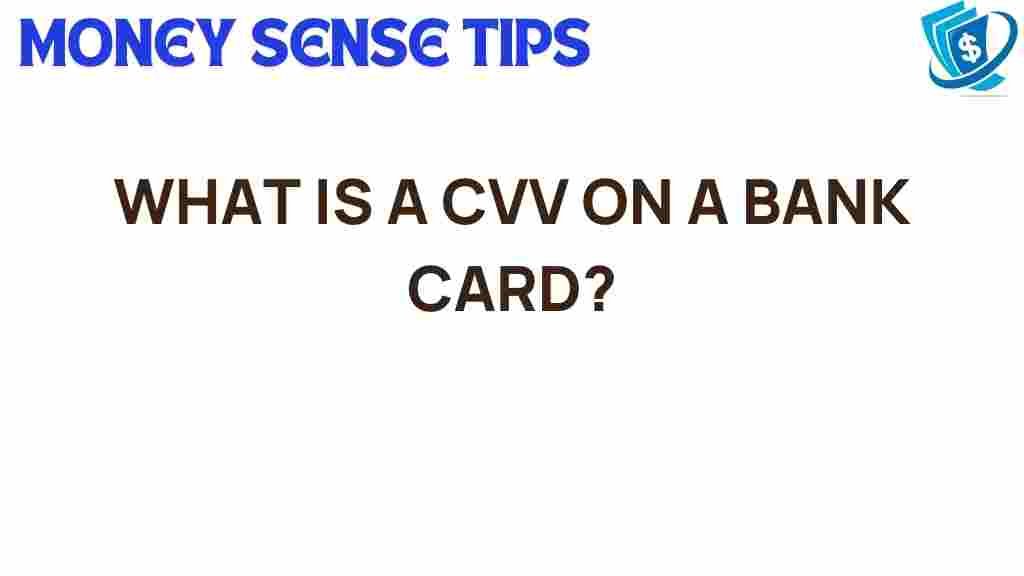Unraveling the Mystery: What is a CVV on Your Bank Card?
In today’s digital world, understanding the various components of bank card security is crucial for anyone who engages in online transactions. One term that often surfaces in discussions about credit card safety is the CVV, or Card Verification Value. This small but significant number plays a key role in payment verification processes and fraud prevention. In this article, we will delve into what a CVV is, how it works, why it is important, and tips for ensuring your banking information remains secure.
What is a CVV?
The CVV is a three or four-digit number printed on your bank card, typically located on the back of credit and debit cards. This code is an essential part of your card’s security features and is used primarily for online and card-not-present transactions. The CVV helps verify that the person making the transaction has physical possession of the card, thus adding a layer of security against fraud.
How Does a CVV Work?
When you make a purchase online, you are often required to provide your card number, expiration date, and CVV. Here’s how the process works:
- When you enter your card details on a secure payment page, the information is sent to the payment processor.
- The processor verifies the card number and expiration date.
- It then checks the CVV against the one on file with the issuing bank.
- If all details match, the transaction is approved; otherwise, it is declined.
This verification process is crucial for ensuring that your transactions are legitimate and that your banking information is protected against unauthorized access.
Why is CVV Important for Bank Card Security?
The CVV is vital for several reasons:
- Fraud Prevention: Since the CVV is not stored with the card number, even if someone hacks into a database and retrieves your card number, they will not have access to your CVV. This makes it harder for fraudsters to carry out unauthorized transactions.
- Payment Verification: The CVV acts as an additional verification step during online transactions, ensuring that the person using the card is the legitimate cardholder.
- Increased Trust: By using CVV codes, merchants can reduce the risk of chargebacks and enhance their trustworthiness with customers.
Best Practices for Using Your CVV
To maintain credit card safety and protect your financial information, consider the following best practices:
- Never Share Your CVV: Treat your CVV like a password. Never share it with anyone or store it in unsecure places.
- Use Secure Websites: Always ensure that the website you are purchasing from is secure (look for “https://” in the URL) before entering your card details.
- Monitor Your Accounts: Regularly check your bank statements for any unauthorized transactions and report them immediately.
- Enable Alerts: Set up alerts with your bank for any transactions made with your card, which can help you catch fraud early.
Common Issues and Troubleshooting Tips
While using your CVV is generally straightforward, you may encounter some issues. Here are common problems and their solutions:
Incorrect CVV Entry
If your transaction is declined due to an incorrect CVV:
- Double-check the number you entered against the number printed on your card.
- Make sure you’re using the correct CVV for the card you are trying to use.
Expired Card or CVV
Sometimes, an expired card can cause issues:
- Check the expiration date on your card. If it’s expired, you will need to use a new card.
- Request a replacement card from your bank if necessary.
Merchant Issues
If the merchant is unable to process your payment:
- Contact the merchant to ensure their payment system is functioning correctly.
- Try using a different payment method if the issue persists.
Understanding Financial Literacy and CVV
Financial literacy is crucial in today’s economy, especially as online transactions become more prevalent. Understanding what a CVV is and how it contributes to bank card security is part of being financially savvy. Here are some aspects of financial literacy related to CVV and banking information:
- Knowledge of Payment Security: Being informed about how payment verification works helps you make safer financial decisions.
- Awareness of Fraud Risks: Knowing the risks associated with online transactions enables you to take proactive measures to protect your information.
- Smart Shopping Habits: Understanding how to safely shop online, including the importance of CVV, can save you from financial loss.
To enhance your financial literacy, consider exploring resources from reputable sites such as Consumer Financial Protection Bureau for tips and tools on managing your finances and safeguarding your banking information.
Conclusion
In conclusion, the CVV is a small yet powerful element of your bank card that plays a crucial role in ensuring your financial safety during online transactions. By understanding what a CVV is, how it contributes to payment verification, and implementing best practices for its use, you can significantly reduce your risk of fraud and enhance your overall banking security. As the digital landscape continues to evolve, staying informed and vigilant is key to protecting your financial information.
For more information on credit card safety and to learn how to keep your banking information secure, check out our detailed guide on online transaction safety.
This article is in the category Security and created by MoneySenseTips Team
